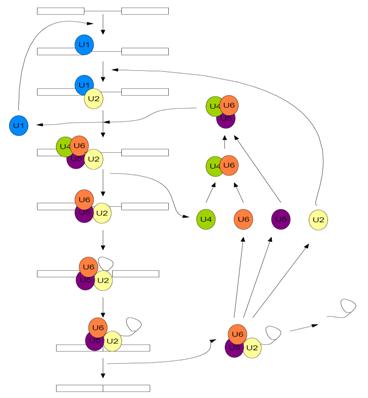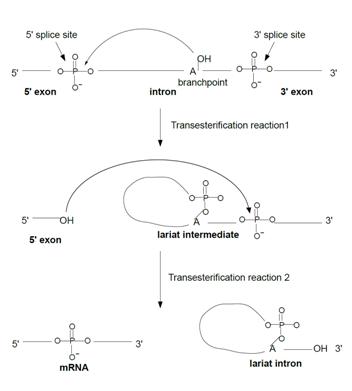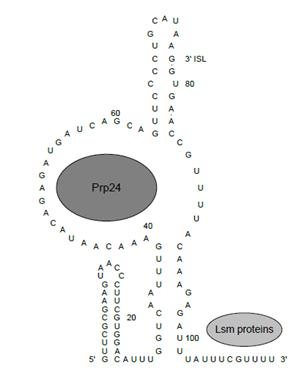Prp24 (Pre-mRNA splicing Protein 24) is a Saccharomyces cerevisiae yeast protein that functions in the formation of base pair interactions between the U6 and U4 snRNPs (small nuclear ribonucleoproteins) to form the U4/U6 di-snRNP during the assembly of the spliceosome [1]. This protein contains four RNA recognition motifs (RRMs) that function in the binding of Prp24 to U6 snRNA [1]. These RRM domains are conserved in structure and sequence in proteins orthologous to Prp24 in Homo sapiens and Schizosaccharomyces pombe, as well as in other proteins containing RRMs [2].
Introduction

Figure 1. Assembly and disassembly of the spliceosome in
Saccharomyces cerevisiae (after Staley and Guthrie 1998
[3])

Figure 2. The transesterificiation reactions of pre-mRNA splicing (after Brow 2002
[4])
Pre-mRNA Splicing
Pre-mRNA splicing is an essential process in eukaryotes that removes non-coding introns from a pre-mRNA transcript and splices coding exons together before the mRNA is exported from the nucleus for translation into a protein[3]. Splicing requires five snRNPs (U1, U2, U4, U5, U6), several other proteins, and the input of energy from ATP. The U1 and U2 snRNPs assemble individually on the pre-mRNA transcript, while U4 and U6 form a U4/U6 di-snRNP before interacting with U5 to form a U4/U6.U5 tri-snRNP that combines with U1 and U2 at the pre-mRNA transcript (Fig 1)[3]. U4 and U1 then depart, and after conformational changes and base pair formation with the pre-mRNA the remaining snRNPs form the catalytically active spliceosome[3]. Two transesterification reactions then occur; the first reaction is the nucleophillic attack of the phosphate group at the end of the 5' exon by the 2' hydroxyl of a specific adenosine at the branch point sequence of the intron (Fig 2)[4]. This is then followed by the nucleophillic attack of the phosphate group linking the 3' exon to the intron by the 3' hydroxyl of the 5' exon[4]. These splicing reactions, as well as the addition of 7-methylguanosine 5' cap and a 3' polyadenosine tail, results in a mature mRNA transcript that can be exported from the nucleus and translated into a protein.
U6 and U4 snRNPs
U6 is considered to be one of the most catalytically important snRNAs in the spliceosome, as it interacts directly with the 5' splice site through base pairing [5]. It is thought to undergo three conformational changes throughout the entire process of splicing and splicesome assembly; it exists as one conformation as free U6 snRNP, another as part of the U4/U6 di-snRNP and as a third when associated with U2 and the pre-mRNA [6] [7]. In addition to Prp24, U6 is associated with seven other proteins, Lsm 2-8, which form a ring around the 3' portion of the U6 snRNA [8].
The U4 snRNA is thought to be non-catalytic because it leaves the spliceosome before the transesterification reactions occur [3]. Its function is instead thought to be aiding U6 in maintaining a conformation that will enable it to interact with U2 and the 5' splice site [9]. The U4 snRNP contains the U4 snRNA, a ring complex of the Sm proteins B-G, and the proteins Prp3, Prp4, and Snu13 [4].
The annealing of the U4 and U6 snRNAs to form the U4/U6 di-snRNP complex, which contains the additional proteins Prp6 and Prp31, is an essential process in the formation of the spliceosome [4]. It enables interaction with the U5 snRNP to form the U4/U6.U5 complex which serves to deliver the U5 and U6 snRNPs to the appropriate sites in the pre-spliceosome complex, forming a catalytically active spliceosome upon departure of U1 and U4 [4].
Role of Prp24 in Splicing
Prp24 is a U6 snNRP protein that functions in the annealing of the U4 and U6 snRNPs during the assembly of the spliceosome. This protein was first identified in a genetic screen as a mutated gene that caused an accumulation of pre-mRNA [10]. Its first functional role was suggested after several mutant forms of the protein were found to suppress a cold sensitive growth defect caused by mutations in the U4 snRNA [11]. It is thought that Prp24 helps to stabilize the U6 snRNA and hold it in a conformation that promotes base pairing interactions with the U4 snRNA to form the stem I and stem II structures of the U4/U6 di-snRNP [12]. Although Prp24 departs from the U4/U6 complex before the formation of the U4/U6.U5 tri-snRNP, it has been suggested that Prp24 may also play a role in the dissociation of U4 from U6 during the base pairing of U6 with U2 and the 5' splice site [13]. This additional role for Prp24, however, has not been sufficiently supported experimentally.
Structure
The key structural elements of Prp24 are the conserved RNA recognition motifs (RRMs). These motifs are found in many proteins with RNA binding properties and contain conserved RNP elements that are recognizable by their primary sequence [11]. For several years, Prp24 was thought to contain three RRMs, termed RRM 1, RRM 2, and RRM 3 [11]. However, analysis of homologs of Prp24 from several different species allowed the identification of a fourth RRM in Prp24 of S. cerevisiae, albeit one that was much less highly conserved and not easily recognizable by its RNP-consensus domain [2].
RNA Recognition Motifs
Prp24 contains four RRMs: RRM 1, RRM 2, RRM 3, and RRM 4. These motifs have a . These RRMs are present in many proteins that bind to single stranded regions of RNA [14] and their presence in Prp24 supports a role for the annealing of U4 and U6 snRNAs into the U4/U6 structure.
Within each RRM there are RNP consensus domains , which are the regions in the β-strands thought to actually interact with the RNA [14]. These regions seem to be very important in Prp24 and its interaction with U4 and U6. The study that first identified a probable link between the Prp24 protein and U4/U6 found that rescued a cold-sensitive phenotype caused by a U4 mutation in stem II of U4/U6 [11]. Two further studies [12] [15] showed that the mutation of of any of the four RRMs conferred either temperature-sensitive growth or lethality to yeast cells.
Structural Models
A recent study [1] examined the structure of of Prp24 by X-ray crystallography. The resultant structure showed Prp24 as an , consisting of eight chains arranged in two nearly symmetrical tetramers[1]. This was the first suggested that Prp24 functioned as an multimer, so it is unclear what the significance of this result is [1]. Their crystal structure also showed extensive interactions between both and , and NMR analysis of protein fragments containing either RRMs 1 and 2 or RRMs 2 and 3 showed that these interactions existed in solution as well[1]. Interestingly, these interactions seemed to block the proposed U6 binding sites of RRM 1 and 2; NMR analysis of the RRM 1 and 2 protein fragment with an RNA oligomer containing the U6 sequences thought to bind the RRMs showed a largely canonical interaction of the RNA with the RRMs, suggesting that Prp24 may undergo conformational changes in the binding of U6[1].
Functional Interactions

Figure 3. Proposed secondary structure of U6 snRNP, with Prp24 stabilizing a large internal bulge on the central stem and the seven Lsm proteins forming a ring around the 3' end of the U6 snRNA (after Karaduman et al. 2006
[16])
Prp24 is part of the normal U6 snRNP, along with seven Lsm proteins (Fig 3)[4]. After interaction with the U4 snRNP to form the U4/U6 di-snRNP, Prp24 departs from the di-snRNP before the addition of U5 to form the tri-snRNP U4/U6.U5 [4]. Through many studies, it has been shown that Prp24 interacts extensively with specific sites on U6, as well with the Lsm protein ring on the 3' terminal end of the U6 snRNA.
U6 snRNA and U4/U6 snRNP
U6 is arguably the most structurally dynamic snRNA involved in the splicing process, seemingly undergoing at least three different structures: it exists in one conformation as free U6 snRNP, another when base paired in the U4/U6 di-snRNP, and a third in base pairing interactions with U2 and the 5' splice site [6]. One large role suggested for Prp24 has been in assisting in the conformational changes between the free U6 structure and the U4/U6 conformation.
Prp24 co-immunoprecipitates with free U6 and U4/U6 di-snRNP, indicating that it is closely associated with these particles [11][17]. Initial investigation of the structure showed that Prp24 very likely binds directly to the 40-43 nucleotides of U6 based on chemical modification of naked U6 snRNA compared to free U6 snRNP[6]. Further investigation suggested that Prp24 binds within the 30-56 nucleotide region of free U6, as well as to stem II of U4/U6 in the 39-56 and 67-70 nucleotide regions of U6 [17].
The main function of Prp24 seems to be directly related to formation of the U4/U6 complex, particularly based on the evidence that Prp24 is present in U6 and U4/U6, but not U4/U6.U5 [11][17][6]. Prp24 greatly increases the rate and efficiency of U4/U6 annealing [18] and mutations in Prp24 have been shown to prevent the formation of the U4/U6 di-snRNP [19]. Although the exact mechanism by which Prp24 promotes annealing of U4 and U6 is not known, it has been suggested that Prp24 may stabilize the secondary structure of U6 to allow it to interact with U4 in order to allow formation of U4/U6 [12].
The interactions of Prp24 with U6 and U4/U6 are very important in proper spliceosome assembly, as evidenced by mutations in Prp24 that suppress mutations in U6 or U4. Mutations in RRM 2 and RRM 3 suppress the effects of mutations in the 3' stem of U6, in a region termed the telestem [12]. A later study showed that RRM 1 binds with high affinity to U6 and is important in interactions with mutations in the 3' region of U6 [15]. Mutations in two RNP consensus domains of Prp24 suppress the effects of mutations in U4 in the stem II region of U4/U6 [11]. Truncation and deletion of internal segments of U6 showed that the central region of U6 is the most important region for interaction with Prp24 and that RRM 1 and RRM 2 are the likely portions of Prp24 that interact with U6 in this region [15]. Deletion of conserved residues in the C-terminal domain of Prp24 caused temperature sensitive growth and reduced levels of U4/U6, suggesting that this region, containing the fourth RRM, is also important for interactions in assembly of the spliceosome [2].
NMR analysis of fragments of U6 sequence and regions of Prp24 have further defined and supported the interactions of the protein with U6 snRNA. Analysis of an RNA oligonucleotide containing sequences identical to nucleotides 41-46 and 83-88 of U6 (the regions proposed to bind to Prp24) with a truncated protein containing RRMs 1 and 2 of Prp24 showed that these RRMs interacted sequence specifically with these nucleotides [1]. Another NMR study identified sequence specific interaction of , and it was determined from this that the most likely region of U6 for interaction was the AGAGAU sequence of nucleotides 49-54, within the region of the previously predicted interaction [20]. From this, it was predicted that RRM 1 would interact with the GAUCAG sequence of nucleotides 55-60 [20].
Lsm Proteins
The Lsm proteins are a set of seven proteins found in the U6 snRNP that form a ring around the 3' end of U6 [8]. An interaction between Prp24 and the Lsm proteins was suggested upon identification of the Lsms and the fact that formation of U4/U6 by Prp24 was less efficient in deproteinized solutions of U4 and U6 snRNAs [18], as well as the identification of a genetic interaction between the genes for Prp24 and Lsm4 [21]. This proposed interaction was further supported by UV cross-linking experiments in which both Prp24 and Lsm4 were immunoprecipitated with U6 after cross-linking [22]. It has also been shown that both Prp24 and Lsm4, as well as the other Lsm proteins, require the 3' end of U6 in order to interact with the snRNA [22], suggesting that this may be the region where the both Lsm proteins interact with U6 and Prp24. Genome-wide protein interaction screens showed that Prp24 interacts additionally with Lsm 2, 5, 6, 7 and 8, and that overexpression of either Prp24 or Lsm4 can complement or intensify the effects of a defect in the other protein [23], further supporting an interaction between the Lsm proteins and Prp24.
Evidence for a direct interaction of Prp24 and the Lsm proteins comes from a study in which the conserved residues in the C-terminal domain of Prp24 were deleted[2]. These deletions resulted in lowered levels of U4/U6 and very little interaction with the Lsm proteins as compared to wild-type Prp24[2]. This indicated that Prp24 interacts directly with the Lsm proteins and the C-terminal domain is necessary for this interaction [2]. Another indication of interaction between Prp24 and the Lsm proteins stems from a study showing that Lsm6 and Lsm7 are necessary in cells that require the recycling of the U4/U6 complex for splicing and that the presence of these two proteins increases the efficiency of annealing of U4 and U6 [24]. This suggests that Lsm6 and 7 are involved in a necessary interaction with Prp24 in the formation of U4/U6 di-snRNP.
More recently, a study has suggested that Prp24 interacts specifically with all the Lsm proteins involved in the U6 snRNP, and that the proteins act together as molecular chaperones to restructure and stabilize the 3' stem of U6 for base-pairing with U4 in stem II of U4/U6[16]. Further support for specific interactions of Prp24 with the Lsm proteins comes from an electron microscopy study that showed Prp24 at specific distances from the subunits of the Lsm ring, suggesting that it interacts from a specified position within the U6 snRNP [16].
Additional Interactions
Several additional roles for Prp24 have been suggested in spliceosome assembly/disassembly, although nothing has been sufficiently supported. A genetic interaction in which Prp24 mutation suppressed a Prp21 (a component of the U2 snRNP) mutation suggested that the two proteins may interact during the base pairing of U2 and U6 at the 5' splice site; however, further investigation failed to produce evidence of a definite interaction between the two proteins, although the authors maintained that a transient interaction between Prp24 and Prp21 may exist in an intermediate form of the assembling spliceosome [13]. It has also been suggested that Prp24 may also assist in the formation of U4/U5.U6 [25] or in the destabilization of U6 from U2 upon completion of splicing to release free U6 snRNP,[12], but there is insufficient evidence to conclusively support these functions of Prp24.



